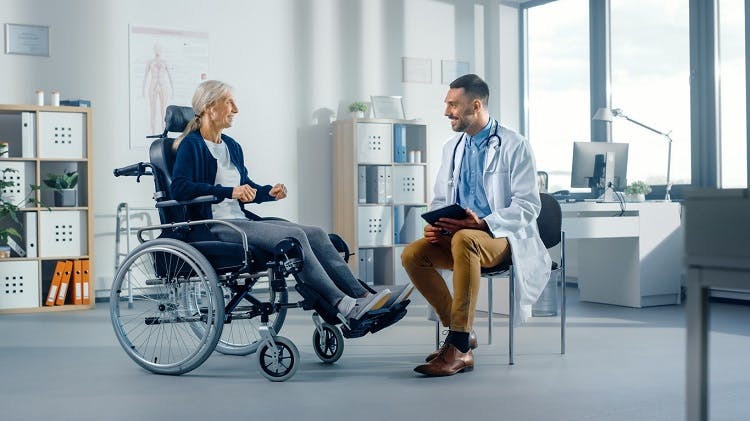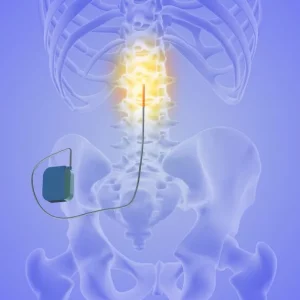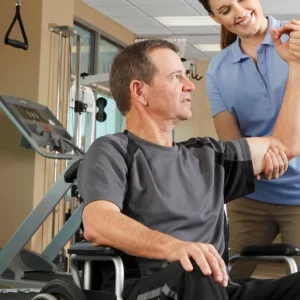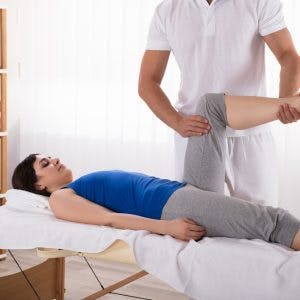The spinal cord serves as the communication pathway between the brain and the rest of the body. After an injury, the transmission of messages may be blocked or interrupted, resulting in a variety of spinal cord injury secondary effects.
Understanding the effects of a spinal cord injury can help you or your loved one take necessary precautions to minimize the risk of complications. This article will discuss the potential spinal cord injury secondary effects, along with effective management techniques to help promote recovery.
How the Spinal Cord is Affected After Injury
The primary functions controlled by the spinal cord are movement and sensation. Thus, damage to the spinal cord can result in various motor impairments such as paralysis or changes in sensation like numbness.
The effects of spinal cord injury that survivors experience differ depending on the severity and level of the injury. These can be determined by using the International Standards for Neurological Classification of Spinal Cord Injury (ISNCSCI). Also known as the ASIA exam, this classification tool involves testing sensory and motor functions at each level of the spinal cord to determine which functions remain intact, and which are affected.
Since specific areas of the skin and sets of muscles are connected to specific levels of the spinal cord, this exam is able to identify the level of injury (the lowest section of the spinal cord where movement and sensation are intact). Higher levels of injury affect functions in the upper (and often lower) body, while lower levels affect functions only in the lower body.
The ASIA exam also helps to identify the severity of a spinal cord injury. In a complete spinal cord injury, the spinal cord is completely severed. Therefore, since there are no spared neural pathways, there is a total loss of all motor control and sensation below the level of injury.
Conversely, in an incomplete spinal cord injury, survivors may have some preserved sensory and motor functions in the areas below the level of injury. This is due to the spinal cord being only partially severed, with some spared neural pathways remaining. During recovery, these spared neural pathways can utilize neuroplasticity, the central nervous system’s ability to rewire itself, to improve functions.
The effects of a spinal cord injury can be rehabilitated with traditional therapies as long as the injury was incomplete. When an injury is complete, rehabilitation will focus on learning compensation techniques to help promote as much independence as possible.
Generally, the less severe a spinal cord injury, the higher the chances of improving function. To understand the rehabilitation process, it first helps to know what potential spinal cord injury secondary effects may arise.
Potential Effects of Spinal Cord Injury
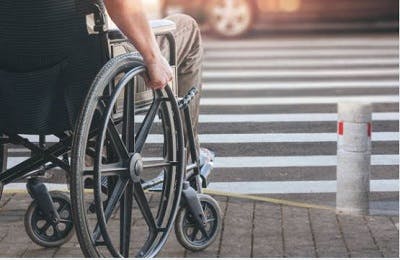
Spinal cord injury secondary effects may develop shortly after the injury or later on during recovery. To prevent these effects from worsening and becoming more serious complications it helps to know what potential spinal cord injury secondary effects may occur and why they may arise.
Be sure to seek emergency medical care if you or your loved one experience any new or recurrent symptoms.
Here are some of the most common spinal cord injury secondary effects:
1. Limited Mobility
In order for movement to occur, the brain needs to send messages down through the spinal cord to the rest of the body. When this flow of messages is interrupted after a spinal cord injury, it can cause weakness or paralysis in the limbs. More specifically, it can cause paraplegia (paralysis of the legs) or quadriplegia (paralysis of the arms and legs), depending on the level of injury.
To improve motor control and restore mobility, it’s essential to stimulate neuroplasticity, which is best activated through high-repetition of exercises, or massed practice. Practicing a movement consistently helps strengthen its neural pathways. Your physical or occupational therapist can provide a rehabilitation plan suitable for your ability level with exercises that focus on improving mobility.
Want 15 pages of SCI recovery exercises in PDF form? Click here to download our free SCI Rehab Exercise ebook now (link opens a pop up for uninterrupted reading)
2. Loss of Sensation
Another common effect of spinal cord injury is impaired sensation. When we touch something, sensory information travels from the body, through the spinal cord, and to the brain. The brain then processes that information and sends signals back down to the body to create a movement-based reaction, if necessary.
When a spinal cord injury disrupts this process, it can result in the inability to process sensory stimuli, causing a lack of sensation, numbness or tingling. Loss of sensation can make it difficult to protect your body from potentially harmful stimuli.
For example, wearing mittens when taking a plate out of the oven helps protect your hands from the heat. If you remove the plate without mittens, sensory nerves will transmit a message to the brain through the spinal cord saying the plate is too hot. The brain then sends a signal through the spinal cord to the muscles to initiate a reaction. This reaction helps prevent your body from serious burns or severe pain.
When the spinal cord is injured, it may be difficult to relay the information to your brain or initiate a reaction. Therefore, if you struggle with sensation deficits after spinal cord injury, it’s important to be extra cautious while cooking or doing any other activity that may increase the risk of accidents.
3. Pain
Chronic pain effects approximately 65% of individuals with spinal cord injuries. Neuropathic pain stems from damage to the nervous system, potentially affecting areas that have been paralyzed or otherwise affected by your injury. This may occur due to a disruption in the flow of sensory signals through the spinal cord to the brain, causing these signals to be misinterpreted as pain.
Treatment may vary depending on the severity of the pain and can include prescribed medication such as non-steroidal anti-inflammatory drugs (NSAIDs), muscle relaxants, and opioids. Electrical stimulation and physical therapy may also be recommended. Speak with your doctor to obtain a proper diagnosis and treatment according to your unique needs.
4. Autonomic Dysreflexia
A secondary effect that most commonly occurs in individuals with a T6 level injury or higher is autonomic dysreflexia, or a sudden overreaction of the autonomic nervous system. The autonomic nervous system controls the regulation of involuntary body functions such as breathing, heart rate, blood pressure, body temperature, and digestion.
Uninterrupted neural communication is necessary for the autonomic nervous system to function properly. Following a spinal cord injury, however, the transmission of messages between the brain and body may be disrupted. As a result, the autonomic nervous system can overreact to stimuli.
There are various factors that can trigger autonomic dysreflexia including a full bladder or constipation, extreme changes in temperature, tight clothing, and skin irritation. Survivors with autonomic dysreflexia may experience sweating, high blood pressure, blurry vision, headaches, blotchy skin, or anxiety.
This spinal cord injury effect can progress quickly, therefore it’s important to know the triggers and address them as soon as possible. For example, you can empty the bowel and bladder at regularly scheduled intervals and avoid wearing clothes that have sharp items on them like zippers or studs.
5. Loss of Bladder and Bowel Control
Bowel and bladder dysfunction can occur when signals from the brain cannot pass through the damaged areas of the spinal cord and reach the bowel and bladder muscles. Loss of bladder and bowel control are common secondary effects because they are regulated by the lowest regions of the spinal cord, making them more susceptible to damage.
Proper bladder and bowel movement are necessary to flush out waste and toxins. When not treated appropriately, loss of bladder and bowel control can result in complications such as constipation, fecal and urinary incontinence, autonomic dysreflexia, and urinary tract infections.
Lack of sensation and impaired reflexes in the body following a spinal cord injury can also make it challenging for individuals to know when to use the bathroom, increasing the risk of urine and waste-related accidents, as well as the development of pressure sores.
While there are management techniques you can try, it’s important to work closely with your doctor and therapist to establish a proper bladder and bowel regimen. They may recommend using catheters, which are inserted into your body to manually empty the bladder. They can also prescribe medication such as laxatives to help ease your bowel movements. Additionally, natural methods, such as drinking water and eating high-fiber foods, can help with the fluidity of your stool.
6. Breathing Difficulties
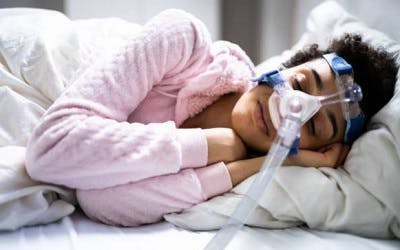
High level cervical and thoracic injuries may result in breathing difficulties. The diaphragm is a large, dome-shaped muscle, and is the primary muscle responsible for respiration. When the diaphragm becomes impaired, especially after high-level cervical injuries (C1-C5), survivors may experience breathing difficulties.
While not as vital, the intercostal muscles located between the ribs also play a role in respiration, and may be affected in a T3-T5 spinal cord injury. Symptoms of impaired respiratory muscles include shortness of breath, heart palpitations, nausea, and abdominal pain.
Damage to the diaphragm can also cause diaphragmatic palsy (weakness of the diaphragm muscle), increasing the chances of respiratory infections. For example, when survivors cannot produce a strong enough cough to clear excess mucus/fluid in the lunges, it can lead to pneumonia, a serious complication of spinal cord injury.
Difficulty breathing can lead to death, therefore it’s crucial to take note of these effects after a spinal cord injury and seek immediate medical attention.
7. Spasticity
Another common secondary effect of a spinal cord injury is spasticity, or involuntary muscle stiffness. Spasticity is caused by disrupted signals between the brain and the areas below the level of spinal cord injury. When spinal reflexes activate a muscle contraction, signals from the brain telling the muscle to relax may not be able to get through, resulting in prolonged contraction.
Individuals with spasticity may experience stiff movements or jerky muscle spasms. When not managed properly, spasticity can cause additional complications such as limited range of motion, contractures (extreme joint stiffness), and body distortions. Therefore, it’s important to work with a physical or occupational therapist if you experience this effect after a spinal cord injury.
8. Clonus
After a spinal cord injury, reflexes can become hyperexcitable to stimulation and cause a condition known as clonus. Clonus refers to involuntary rhythmic shaking of the limbs after spinal cord injury, particularly when the limb is stimulated.
Although it most commonly occurs in the ankles and feet, survivors may also experience it in different areas depending on the level of injury. This can include the calves, knees, wrists, triceps, and biceps.
Studies have shown that clonus typically develops about 2 months after a spinal cord injury and can concurrently be present with spasticity. If not properly managed, severe clonus can disrupt your sleep, cause daytime fatigue, and make it difficult to perform self-care tasks.
9. Sexual Dysfunction
Sexual functions may be affected by a spinal cord injury due to impaired sensation, and it affects men and women differently. While men are still able to get erections and women are still able to get pregnant, the level of arousal and pleasure during intercourse may be affected. Talk to your doctor or a therapist with specialization in this area for treatment ideas.
10. Sleep Apnea
Spinal cord injury secondary effects may also consist of sleeping disorders such as sleep apnea. Sleep apnea is a condition characterized by unstable breathing (breathing starts and stops) during sleep. As a result, individuals may wake up multiple times throughout the night, interfering with a full night’s rest. Individuals may experience excessive snoring as well as daytime fatigue.
A continuous positive airway pressure device (CPAP) supplies pressurized air into your airways while you sleep. This machine can help treat sleep apnea and other respiratory difficulties. Consult with your doctor if you are unable to sleep well during the night after sustaining a spinal cord injury.
Management Techniques for the Effects of Spinal Cord Injury

The spinal cord injury effects listed above all have something in common: they are the result of miscommunication between the brain, spinal cord, and rest of the body. Fortunately, the spinal cord can rewire itself via neuroplasticity in spared neural pathways.
Spared neural pathways are seen in incomplete spinal cord injuries as opposed to complete spinal cord injuries where the spinal cord is fully severed. In order to activate neuroplasticity after an incomplete SCI, individuals must repeatedly practice weakened or affected movements.
Think of the phrase “use it or lose it!” Neuroplasticity is occurring all the time, not just after the injury. It can promote or impede recovery based on your dedication to the rehabilitation process. The more you practice a function, the higher the chances of improving and restoring that function.
To help manage spinal cord injury effects you can engage in the following types of therapy:
- Physical therapy: Physical therapy focuses on improving mobility by promoting high repetition of therapeutic exercises to encourage neuroplasticity and functional movement patterns. This can include a variety of exercises for paraplegia and quadriplegia, depending on your level of injury. Physical therapists can address mobility-related concerns such as pain and spasticity, too.
- Occupational therapy: Occupational therapy focuses on helping survivors adapt to their ability level and maximize independence after spinal cord injury. Therapists can provide exercises that mimic daily activities such as bathing and eating. Adaptive equipment may also be recommended for those with complete and incomplete injuries to make tasks easier.
- Speech therapy: Speech therapy is especially helpful for high-level spinal cord injuries that cause respiratory effects. Speech-Language Pathologists can provide exercises that focus on managing secretions and increasing diaphragm strength.
While therapy helps treat the root cause of the secondary effect, you can also use compensation techniques to help reduce some of the symptoms. For example, medications such as baclofen can help with spasticity and orthoticscan help promote proper musculoskeletal alignment and mildly stretch tight muscles.
Consult with your therapist to find the most effective compensation techniques for you. Your therapist can also provide you with a home exercise program to keep neuroplasticity stimulated between therapy sessions.
Overcoming Effects of a Spinal Cord Injury
The effects of a spinal cord injury depend on the level of injury. For instance, high level cervical injuries may result in quadriplegia while lower level injuries may result in paraplegia. Rehabilitation is crucial to address any secondary effects and reduce the risk of further complications.
The best way to promote recovery is to stimulate the central nervous system through high-repetition of exercises. Survivors must engage in massed practice to improve mobility, sensation, and restore as much overall function as possible. We hope this article helped you understand the types of spinal cord injury secondary effects that may arise, and encouraged you to seek immediate medical care if needed.
